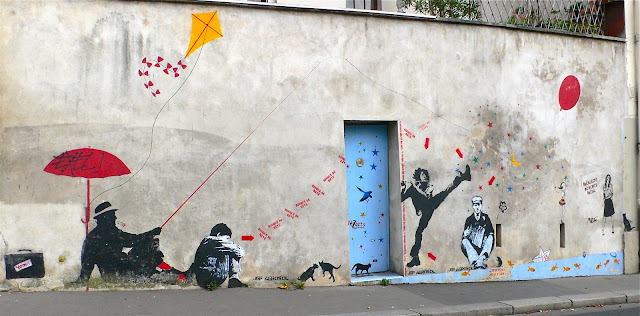I'm not a fan of graffiti per se, however, from time to time when riding an urban train, my gaze has been drawn to some amazingly colorful and gaudy, if not interesting works. But less and less; paint is more and more expensive.
Although the 1970s New York graffiti explosion didn't arrive in Paris until the 1980s, according to French sociologist Alain Vulbeau it wasn't until 1988 that the proliferation of tags, or scrawling signatures, became unbearable for the Parisian population. Journalists stopped speaking of graffiti in benevolent terms, and in the public mind, taggers were urban vandals exceeding the bounds of street art. Authorities put the brakes on the graffiti movement, especially for legally responsible adult
graphistes, by criminalizing the defacement of public property and making violations punishable by high fines and prison sentences.
Paris, and other French cities with the financial means to do so, mobilized anti-tag cleaning forces. Since 2000 the mayor of Paris has hired two private enterprises to patrol and rapidly remove graffiti from private and public walls. The result is that within the city limits, on any given afternoon Paris seems to be remarkably tag free, the cleanup squads having already erased the previous nights' tags. In a single year, this amounts to more than 130,000 square meters of graffiti. (If you look closely, you might notice that the lower one to two meters of some buildings look much cleaner than the upper parts...due most likely to tag removal in the past.)
 |
| "Free spray" construction fence known as Espace Graff which has recently been removed at the Palais de Tokyo. |
Another preventive measure has been to tolerate graffiti on certain walls within Paris to give
graffeurs who paint large, colorful calligraphy
"fresques" a place to express themselves. One of the most prominent "free-spray" walls had been a construction fence, known as the
"Espace Graff" along the edge of the Palais de Tokyo, a building on the Seine dedicated to modern and contemporary art. Although that metallic
palisade has been recently removed, puerile taggers continue to frequent the area, regrettably and regularly defacing the statuary of the reclining Nymphes.
Beauty is in the eye of the beholder...
While I'm on the subject, I should mention that what is intended to be
the reference book of Parisian graffiti goes officially on sale today, November 29, 2010. It's twenty-seven years of archives depicted in some 2200 photos of heaven-only-knows how many kilograms of spray paint applied illicitly, and in some cases licitly, to create a multitude of calligraphies and pop imagery; an imagery that has notably marked the Parisian urban and suburban railway lines' landscapes as well as maintenance budgets. The 300 page
Paris City Graffiti is being sold online at
http://pariscitygraffiti.com/
This post is a continuation of the previous two posts and contains excerpts, with minor revisions, from an article I wrote for France Today magazine, entitled Inside Outsider Art.
Text & photos © P.B.Lecron




























































